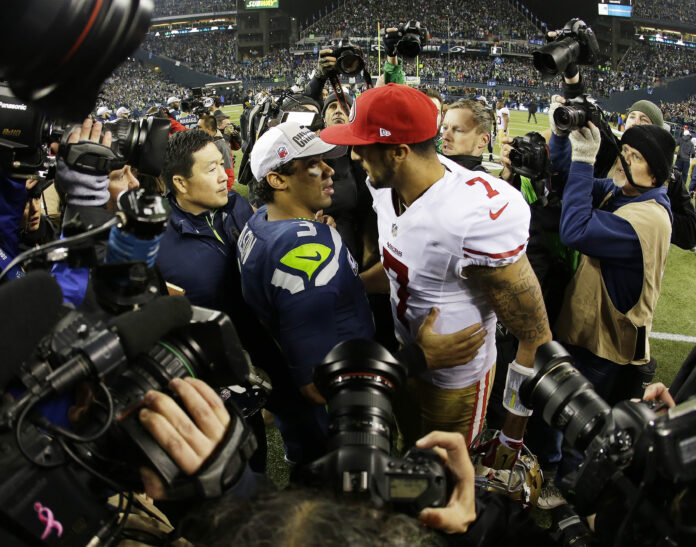Soccer is considered the ultimate team sport, with every player believed to be crucial.
However, the quarterback role is often seen as significantly more pivotal than the rest.
Naturally, having been a former quarterback, I wholeheartedly concur.
But what if a general manager and head coach opted to challenge the prevailing NFL paradigm?
At the very least, it should be a topic of discussion and thorough analysis in their strategic planning sessions.
We are witnessing its success unfold right in front of us. It presents an entirely fresh perspective on the game, one that I believe deserves, at the very least, a thorough examination.
Russell Wilson is rapidly ascending to the ranks of elite quarterbacks.
Many argue he’s already there. Selected in the 3rd round of the 2012 draft, he’s now in the third year of his four-year rookie contract.
Teams are hesitant to let star players reach the final year of their contract, as it weakens their negotiating position and increases the risk of losing a key player.
Given this, most anticipate that Wilson will secure a substantial deal this offseason, likely in the range of $20 million per year for multiple seasons.
This represents a significant portion of Seattle’s salary cap, prompting them to prepare.
As players, we recognize that these preparations often start quietly, informally, and away from public scrutiny.
With Seattle emerging from their bye-week, conducting a thorough evaluation of the roster, both in the present and future is standard practice. It’s a chance to step back and assess the situation.
What if teams made the unconventional choice not to invest heavily in their franchise quarterback?
What if Seattle opted to let Wilson go and search for a replacement?
People might call for GM John Schneider’s dismissal, and while we’re at it, they might say it’s time for Pete Carroll to move on, too.
It may sound radical, but could it potentially be the right decision?
Before you brandish your pitchforks, let me clarify that I’m an enormous Russell Wilson enthusiast.
I believe he’s one of the most dynamic young quarterbacks in the league, and his level of success is truly remarkable.
On and off the field, he demonstrates exceptional qualities.
His precision is top-notch; he excels as a pocket passer, swiftly progresses through his reads, and stands out as one of the premier playmakers in the league at the QB position.
Remarkably, he manages to avoid turnovers. Wilson possesses a rare blend of intelligence, athleticism, accuracy, composure, leadership, and decision-making prowess.
Furthermore, he comes at an incredibly reasonable cost. In fact, by NFL standards, he’s downright affordable.
This season, Wilson is set to earn a base salary of $662,000.
In stark contrast, players like Peyton Manning, Tom Brady, Aaron Rodgers, Drew Brees, Joe Flacco, and Matt Ryan will carry a cap hit of around $20 million for their respective teams.
That amounts to roughly 15% of their team’s total budget, all allocated to one position.
Now, consider a scenario where a team automatically enjoys a salary cap advantage of $20 million over every other team.
They would likely boast a formidable lineup across multiple positions.
The extra financial flexibility would enable them to secure pricier free agents and retain their current talent pool.
This added depth would position them to dominate opponents and seamlessly substitute injured players with seasoned veterans rather than relying on undrafted rookies—providing a significant advantage that few teams have enjoyed in recent years.
As the 2013 season drew close, a consensus emerged among NFL fans and players that the Seahawks and 49ers stood as the top two teams in football.
Following Seattle’s dominant performance against Denver in the Super Bowl, many argued that the true championship had occurred two weeks earlier in the NFC Championship game.
Russell Wilson and Colin Kaepernick faced off in a showdown that was decided in the closing moments.
Both quarterbacks delivered impressive performances, were operating under their rookie contracts, earning less than $1 million, and were known for their multi-faceted playing styles.
Heading into the 2013 season, Seattle and San Francisco were among the most active teams in free agency.
It seemed that almost every available free agent was a potential candidate to join their ranks, and indeed, many did.
They operated with a narrow window to allocate significant resources to the rest of their roster.
It was clear that, at some point, their quarterback would secure a substantial contract, and the aggressive spending spree would have to come to an end.
If teams are constantly looking for an edge and researching the best ways to win a championship, they wouldn’t be thorough if they didn’t discuss the “non-franchise” quarterback model
That’s precisely the path San Francisco took this offseason.
They inked Kaepernick to a new contract that amounts to roughly $16 million for this season.
While most anticipate the 49ers to be in contention come late December, they’ve kicked off the season with a 2-2 record.
Their activity in free agency during the offseason was somewhat subdued, and both guard Alex Boone and tight end Vernon Davis are seeking contract extensions.
Finances are a bit tighter now in San Francisco, and though it may not be immediately apparent, it will likely impact their overall depth as the season progresses.
So, what’s the alternative for a team that does not give their young Pro Bowl quarterback a massive extension? My suggestion is to consider a shift in the NFL’s salary cap framework.
Most teams invest substantial time and resources in their quest for a franchise quarterback.
They meticulously scout both college prospects and potential NFL backups, causing general managers to lose sleep over the process.
After a few misses, they eventually identify their guy and reward him with a blockbuster extension.
But why?
It seems to be a widely held belief that having an elite quarterback is the key to success.
However, right before our eyes, we witnessed the top two NFL teams compete with quarterbacks who weren’t first-round picks and didn’t fit the traditional pocket passer mold.
Surprisingly, there’s been a reluctance to adopt this approach elsewhere.
If teams were to embrace this model, I envision it would look something like this:
First and foremost, there would be a yearly investment in quarterbacks through the draft.
Thanks to the new Collective Bargaining Agreement (CBA) and the lower contracts for first-round picks, teams could select a player at any position without a substantial cap hit.
The focus would be on identifying players with unique skill sets—quarterbacks who don’t conform to the typical NFL archetype.
The goal would be to construct an offense tailored around these players, proving challenging for opposing defenses to counter.
Players with exceptional running abilities would be highly sought after.
Given that they may not be with the team for a dozen years, concerns about wear and tear from running would be less pressing.
A shorter stature would be acceptable, and a cannon for an arm wouldn’t be a prerequisite.
Accuracy would be of greater importance. A competitive and resilient mindset would be non-negotiable, as games might be won in gritty, old-school fashion, demanding a player who can grind it out.
Even if a team uncovers a hidden gem like Wilson, they would need to draft another quarterback the following year and the year after that.
By the time the starter completes their fourth year, the backups would be poised to step in.
In the unfortunate event of an injury to the starter, there would be capable replacements waiting in the wings.
It’s even conceivable that one of them could contribute to special teams.
The third-string quarterback might possess the athleticism to excel in kickoff coverage, tallying up some tackles.
Crucially, the linchpin of this strategy lies in the surplus salary cap space.
That extra $20 million could be allocated towards bolstering the roster—shoring up an aging offensive line, adding depth at tight end and wide receiver, and reinforcing the defense.
Players of the caliber of Richard Sherman and Earl Thomas could receive well-deserved contract extensions.
The defensive line could be fortified to apply relentless pressure on opposing offenses. You get the idea.
The purpose of this thought exercise is to envision an alternative approach to how the NFL compensates its players.
The significance of running backs has noticeably diminished in recent years.
Could the same trend eventually extend to the value of quarterbacks?
Will Seattle commit to paying Russell Wilson those substantial sums? I have no doubt they will. Is it a prudent move? Likely.
However, if teams are consistently seeking advantage and exploring the most effective methods to secure a championship, they would be remiss not to deliberate on the “non-franchise” quarterback model.
I’m reasonably sure that few would be willing to take the risk, as failure could have severe professional repercussions.
Yet, I don’t believe it’s entirely implausible to entertain the idea of its potential success.

